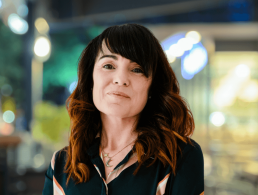Prof Manolya Kavakli-Thorne, programme lead for gamification and simulation technology, discusses merging her creativity with a love for computers and all things technical.
People generally find comfort in putting others into boxes, often leading to an oversimplification of how people truly operate. We can often be guilty of gathering the information we need and using just one or two traits to make fundamental judgments about who person is, for example the bookworm is reserved or the scientist is logical and overly serious.
Innocuous as it may seem it can be detrimental to reduce a person in this way, as they might then feel pigeon-holed when it comes to making significant decisions, such as choosing a career.
Prof Manolya Kavakli-Thorne, programme lead for gamification and simulation technology at Aston University in the UK, has spent a lifetime merging her creative side with her admiration for technological innovation.
“I started studying architectural engineering when I was 16 and graduated as an architect at the age of 20,” Kavakli-Thorne told SiliconRepublic.com. Soon she found herself fascinated by what computers could do for the domain of architecture and realised she wanted to encourage other people to consider combining their skills with the innovations being made in the world of tech.
“I loved architecture so much that I wanted to free architects from laborious tasks of drafting and empower them,” she said. She wanted to help them focus on the “creative side [and] taking advantage of computer technology”.
Pioneering journey
Aiming to empower other architects to embrace technology, Kavakli-Thorne decided to focus her efforts on the development of computer programmes “by customising CAD (computer aided design) packages to help architects” that would take over heavy drafting tasks.
She earned an MSc and a PhD on AI applications in design. In her postdoctoral work she turned her focus to an AI application for the transformation of 2D sketches into 3D geometric models, obtaining a NATO Science fellowship to work on this.
Hard work and curiosity took her to Istanbul where she became an assistant professor at Istanbul Technical University, before moving to University of Sydney in Australia to continue working on design computing and cognition for interface design. She later became the course coordinator of an entirely new degree, the Bachelor of Computing (Games Technology), at Charles Sturt University.
Over the years, she built up an interest in computer graphics and was excited about the potential for advancement. Seizing the opportunity to make an impact in the field, Kavakli-Thorne moved back to Sydney as a senior lecturer to teach computer graphics and games design and to establish a pioneering virtual reality (VR) Lab at Macquarie University.
“In 2015, I also established a simulation hub, integrating VR Lab with flight simulators, driving simulators and motion capture labs. I worked at Macquarie University for 20 years and I am still an honorary professor there,” she said.
The foundation of the VR lab and the simulation hub were significant moments in Kavakli-Thorne’s career.“These facilities helped me to train plenty of researchers to develop virtual and augmented reality interfaces and conduct research on human information processing.”
Her pioneering work developing models using speech and gesture recognition systems, integrating VR with robotics and making use of game engineering, also involved the training of more than 20 PhD students, more than 50 master’s students and the placement of “60 IT professionals into workplaces after their graduation, with specific expertise in these fields”.
Another shift to occur during Kavakli-Thorne’s career, she noted, was a gradual change in the representation of women within the IT sphere.
“For some, it was difficult to see a female in an equal position to them. There were no female role models in senior roles and we had to create our own networks,” she explained. She benefited from the guidance and support of a mentor, her PhD supervisor Prof Nigan Bayazit. “She was an amazing woman, very smart, and she was able to recognise my skills and what I could do.”
Looking to the future, there is much to be done. When she first began her career in the world of IT, AI design was where she cut her teeth, but the tech just had not come far enough, prompting an advantageous move to AR and VR.
But she noted, as people become less siloed and there is an increase in interdisciplinary work. “Joining all of those dots [will] bring exciting developments.” She predicts data science, AI and ML “will be big in the future”, resulting in a need to train students in these areas. “Future jobs will be in these domains.”
Does she have any advice for people looking to move into a tech-focused career? “Do not give up.
“When you are a champion, you need to wait for others to catch up with you and understand what you are saying. You need to be patient.”
Find out how emerging tech trends are transforming tomorrow with our new podcast, Future Human: The Series. Listen now on Spotify, on Apple or wherever you get your podcasts.




